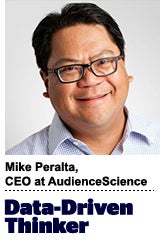 “Data-Driven Thinking” is written by members of the media community and contains fresh ideas on the digital revolution in media.
“Data-Driven Thinking” is written by members of the media community and contains fresh ideas on the digital revolution in media.
Today’s column is written by Mike Peralta, CEO at AudienceScience.
While many like to believe that advertising is a mystical combination of art and science mastered by a few qualified geniuses, the truth is that there are only a few visionary companies that can revolutionize the industry. When something works for one major advertiser, the industry quickly tries to repeat the strategy.
That’s why many are paying attention to Procter & Gamble’s recent decision to divide its media budget between Omnicom Media group and Dentsu’s Carat, rather than keep all accounts with a single agency.
What we’re seeing today is a shift in the way brands have traditionally handled their digital media buying, one that many more are likely to follow. It is no longer about consolidation under one agency for buying power. Programmatic has brought an era of disintermediation to the industry, where ad messages can reach audiences at scale through automated channels, thus rendering a single agency’s buying power irrelevant.
P&G will continue to look at its agency lineup, with an emphasis on media, due in part to the “rapid acceleration of capabilities in the digital world,” Marc Pritchard, P&G’s global brand officer, told Ad Age.
Moves like this don’t happen in a vacuum, of course, and coincidentally the news broke on the same day that the ad industry was parsing out the latest forecasts from Magna Global and ZenithOptimedia. Both show global spending on the rise, spurred by digital. But the most interesting stat is an anticipated decline in TV spending next year, coinciding with digital overtaking TV in either 2016 or 2018, depending on whose numbers you like better.
Digital media’s meteoric rise is due in part to the rapidly accelerating capabilities for buying, targeting and serving ads. Accessibility and reliance on these tools and technologies has changed the brand and agency dynamic in fits and starts over the past half-decade, but this news is a harbinger of major change. As more large global advertisers gain sophistication and experience with the digital tools required for reaching consumers, they, too, will likely take a closer look at their digital strategies and change the way they work with media buying agencies.
Scale is a driving factor. Where it was once within the brands’ best interest to consolidate spend to leverage an agency’s buying power, that’s no longer the case online. Marketers need both scale and accuracy, and greater access to accurate consumer data and technology means that brands can see more of the available inventory online and make their own informed decisions on which impressions to buy, choosing to only reach known consumers or those who match similar profiles.
This ability to find target customers across the web eliminates spending on wasted impressions. Brands will become more selective in which online impressions they buy, in some cases passing on as much 90% of the ad inventory available in order to match the right ad to the right consumer on the right device. Scale buys negotiated by the agency on Yahoo or YouTube quickly lose their value in this ad economy.
As more brands go this route, agencies will have to refocus on their historic core competencies of media strategy, planning and creative execution. Brands will need agencies to execute campaigns that cannot be transacted through technology platforms, as well as to connect the on- and offline efforts. It will be more important than ever for agencies to own the cross-channel vision of how a brand is presented to consumers, especially the creative execution.
The digital media landscape will continue to change dramatically in the coming years. Mobile content consumption is growing, and will account for 50.2% of all online advertising by 2018, according to ZenithOptimedia. Video is exploding with more premium pre-roll inventory entering the marketplace, and marketers have barely scratched the surface of wearables and connected appliances.
All of this will cause further change to the relationship between advertisers and agency, but that’s not bad for the industry. In 2016 we can expect major marketers to act on the knowledge that digital is no longer a second fiddle to TV and take more control into their hands.
Agencies will always have a seat at the table, but as the largest of advertisers seek to connect with their audiences in the most efficient ways possible, the agency’s role will look a little different.
Follow AudienceScience (@audiencescience) and AdExchanger (@adexchanger) on Twitter.













